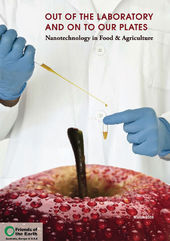Nanotechnology involves the ability to control matter at the scale of a nanometer - one billionth of a meter. The world market for products that contain nanomaterials is expected to reach $2.6 trillion by 2015.
So says a report from the Government Accountability Office (GAO): Nanotechnology: Nanomaterials Are Widely Used in Commerce, but EPA Faces Challenges in Regulating Risk. (GAO-10-549, May 25, 2010)
GAO identified a variety of products that currently incorporate nanomaterials already available in commerce ... [in] food and agriculture ...The extent to which nanomaterials present a risk to human health and the environment depends on a combination of the toxicity of specific nanomaterials and the route and level of exposure to these materials. Although the body of research related to nanomaterials is growing, the current understanding of the risks posed by these materials is limited.The effects of nanotechnology on the environment are regulated by the EPA (Environmental Protection Agency), which is why this report targets recommendations to EPA.
Shouldn't some of those recommendations be directed toward FDA, the agency that regulates food safety? Maybe GAO needs to do another report?
In the meantime, the European Food Safety Authority is preoccupied with issues related to the safety of food nanotechnology:
"The risk assessment framework for nanotechnology in Europe - like so much else connected to the technology - appears to be in its infancy but developing at a rapid pace ... Nano knowledge gaps have led some to call for a ban on the use of nanomaterials in food products until their safety has been fully established. One area of concern is whether nanoparticles can migrate from packaging materials into foods.Last April, the European Parliament's environment committee said nanotech products should be withdrawn from the market until more is known about their safety. In June, that committee added that nanotech foods should be assessed for safety before they are approved for use and labeled.
In seeking to assess nanomaterials, the food safety body repeatedly used phrases such as "specific uncertainties", "limited knowledge" and..."difficult to characterize, detect and measure" in relation to toxicokinetics and toxicology in food. Likely usage and exposure levels are also largely a mystery.
The European Food Safety Authority says that lack of knowledge means that risk assessment of risk assessments must be done on a "cautious case-by-case approach."
Doesn't that sound reasonable? Let's hope it's not too late to put such constraints in place, and in the U.S., too.




Comment: Read the following articles carried on SOTT about the "specific uncertainties" of nano materials, especially in food:
Food Industry 'Too Secretive' Over Nanotechnology
Alert over the march of the 'grey goo' in nanotechnology Frankenfoods
Nanotechnology - the new threat to food - from the article: On the subject of 'further loss of privacy as nano surveillance tracks each step in the food chain' read the following:
Big Pharma Nanotechnology Encodes Pills with Tracking Data That You Swallow